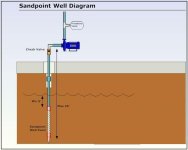forgeblast
Elite Member
Hi all, I have a water weep on our property (a place where the water pushes up through the ground) not really a spring but it is wet all year long.
Its almost at the bottom of our property so it has to be coming from all the run off down our hill.
I was wondering about making it into a spring, or for a shallow well to have an emergency water source.
I cannot find any info on what to to with it (googled keep getting willow trees ).
).
Has anyone developed a weep, or do you have any info on what to do with one.
thanks
Forgeblast
Its almost at the bottom of our property so it has to be coming from all the run off down our hill.
I was wondering about making it into a spring, or for a shallow well to have an emergency water source.
I cannot find any info on what to to with it (googled keep getting willow trees
Has anyone developed a weep, or do you have any info on what to do with one.
thanks
Forgeblast



